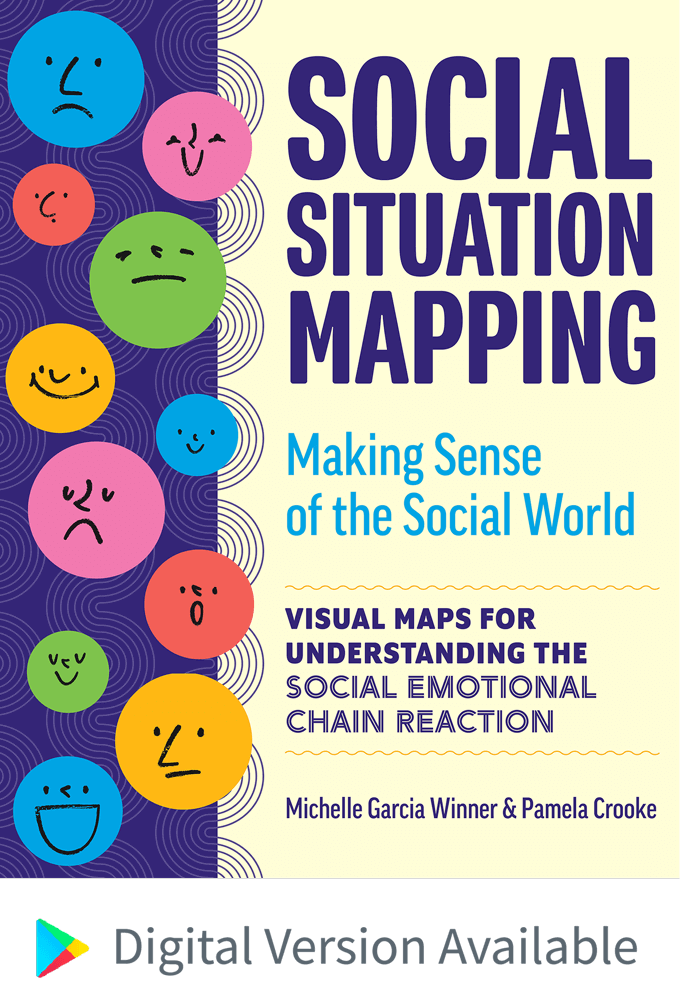Research Resources
Evidence-Based Concepts for Social Situation Mapping
Cognitive Behavior Therapy (CBT); Perspective Taking & Theory of Mind; Social Skills; Visual Supports; Social Attention; Self-Awareness; Self-Regulation; Social Emotional Learning; Executive Functioning; ASD; Social Cognition; Positive Behavioral Interventions and Supports (PBIS); Response to Intervention (RTI)
Bauminger, N. (2007a). Brief report: Group social-multimodal intervention for HFASD. Journal of Autism and Developmental Disorders, 37, 1605-1615.
Bauminger, N. (2007b). Brief report: Individual social-multi-modal intervention for HFASD. Journal of Autism and Developmental Disorders, 37, 1593-1604.
Beaumont, R., & Sofronoff, K. (2008). A multi-component social skills intervention for children with Asperger syndrome: The junior detective training program. The Journal of Child Psychology and Psychiatry, 49(7), 743-753.
Cardaciotto, L., & Herbert, J. (2004). Cognitive behavior therapy for social anxiety disorder in the context of Asperger’s syndrome: A single-subject report. Cognitive Behavioral Practice 11, 75-81.
Chalfant, A., Rapee, R., & Carroll, L. (2007). Treating anxiety disorders in children with high functioning autism spectrum disorders: A controlled trial. Journal of Autism and Developmental Disorders, 37, 1842-1857.
Crooke, P., Hendrix R., and Rachman J. (2008) Brief Report: Measuring the Effectiveness of Teaching Social Thinking to Children with Asperger Syndrome (AS) and High Functioning Autism (HFA). Journal of Autism and Developmental Disorders, 38 (3) pp. 581-91.
Epp, A. M. & Dobson, K. S. (2010). The evidence base for cognitive-behavioral therapy. In K.S. Dobson (Ed.), Handbook of cognitive-behavioral therapies. (pp. 39-73), New York, NY: Guilford Press.
Koning, C, Magill-Evans, J., Volden, J., Dick, B. (2008). Efficacy of cognitive behavior therapy-based social skills intervention for school-aged boys with autism spectrum disorders. Research in Autism Spectrum Disorders, 7 (10), pp. 1282-1290.
Lehmkuhl, H., Storch, E., Bodfish, J., & Gefken, G. (2008). Brief report: Exposure and response prevention for obsessive compulsive disorder in a 12-year-old with autism. Journal of Autism and Developmental Disorders, 38, 977-981.
Lopata, C., Volker, M. A., Toomey, J. A., Chow, S. Y., & Thomeer, M. L. (2008). Asperger’s and other high functioning autism spectrum disorders: A review of group-based social enhancement research and a model for school-based social intervention. In D. H. Molina (Ed.), School psychology: 21st century issues and challenges (pp. 299–325). Hauppauge, NY: Nova Science.
Ooi, Y., Lam, C., Sung, M., Tan, W., Goh, T., Fung, D., et al. (2008). Effects of cognitive-behavioral therapy on anxiety for children with high-functioning autistic spectrum disorders. Singapore Medical Journal, 49(3), 215-220.
Reaven, J., & Hepburn, S. (2003). Cognitive-behavioral treatment of obsessive-compulsive disorder in a child with Asperger syndrome. Autism, 7(2), 145-164. 12.
Rotheram-Fuller, E., & MacMullen, L. (2011). Cognitive-behavioral therapy for children with autism spectrum disorders. Psychology in the Schools, 48(3), 263-271.
Scarpa A. & Lorenzi, J. (2013). Cognitive-behavioral therapy with children and adolescents: history and principle. In A. Scarpa, S. W. White, & T. Attwood, (Eds.), CBT for children and adolescents with high-functioning autism spectrum disorders (pp. 3-26), New York, NY: Guilford Press.
Scarpa, A., White, S. W., & Attwood, T. (Eds.). (2013). Cognitive-behavioral interventions for children and adolescents with high-functioning autism spectrum disorders. New York, NY: Guilford Press.
Sofronoff, K., Attwood, T., & Hinton, S. (2005). A randomised controlled trial of a CBT intervention for anxiety in children with Asperger syndrome. Journal of Child Psychology and Psychiatry, 46, 1152-1160. 13.
Sofronoff, K., Attwood, T., Hinton, S., & Levin, I. (2007). A randomised controlled trial of a cognitive behavioral intervention for anger management in children diagnosed with Asperger syndrome. Journal of Autism and Developmental Disorders, 37, 1203-1214.
Sze, K., & Wood, J. (2007). Cognitive behavioural treatment of comorbid anxiety disorders and social difficulties in children with high-functioning autism: A case report. Journal of Contemporary Psychotherapy, 37, 133-143.
Sze, K., & Wood, J. (2008). Enhancing CBT for the treatment of autism spectrum disorders and concurrent anxiety. Behavioural and Cognitive Psychotherapy, 36, 403-409.









